Media | Articles
Spreading the LUV: A brief history of Detroit’s mini-trucks
What better way for a gearhead to celebrate Valentine’s Day than with tiny trucks that make you say “aww”? We originally published this story in the summer of 2018; it’s back because LUV lasts forever. –EW
It might be hard to imagine, given the current, cutthroat state of the pickup truck segment, but there was once a time when these task-focused haulers were largely an afterthought to the bean counters in Detroit. Fifty years ago, before King Ranches and Longhorns lined their interiors with enough leather to reach from Lansing to Laredo, trucks were barebones affairs built to get the job done and sold to customers who honestly weren’t expected to use them as daily drivers.
An even more hands-off approach was applied to the burgeoning compact-truck scene, which caught the Big Three completely off-guard at the beginning of the 1970s. General Motors, Ford, and Chrysler had essentially ignored the small pickups being imported by Toyota and Datsun throughout the previous decade, blissfully ignorant of the fact that a growing cohort of buyers was willing to take a chance on a “foreign” brand if it meant an easy-to-drive truck that offered decent practicality and a low purchase price. In fact, it’s safe to say that Datsun (now Nissan) carved out its first important foothold in America by way of its 320/520 series of mini-trucks.
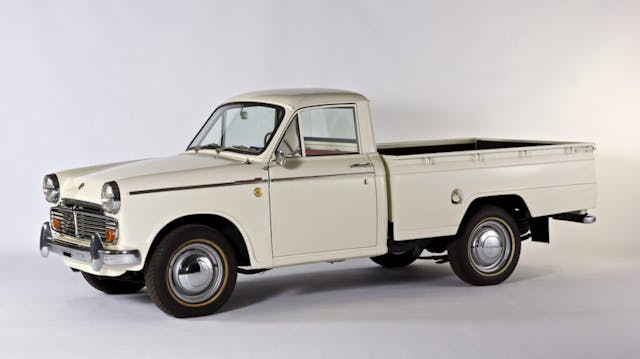
Scrambling to capture a demographic they hadn’t even known existed, Michigan’s best minds had to come up with a compromise, and quickly, until they could marshal the resources required to develop their own homegrown trucks. The result was a series of captive imports rebadged to battle the best that Japan had to offer … with the best that Japan had to offer. Each automaker was able to avoid the egregious 25-percent “Chicken Tax” by importing its rigs in chassis cab configuration for final assembly stateside.
Let’s take a look at the trio of mini-trucks fielded by Detroit for that awkward 10-year stretch that lasted right up until the likes of the Ranger and S10 took over the reins.
Marketplace
Buy and sell classics with confidence
Chevrolet LUV
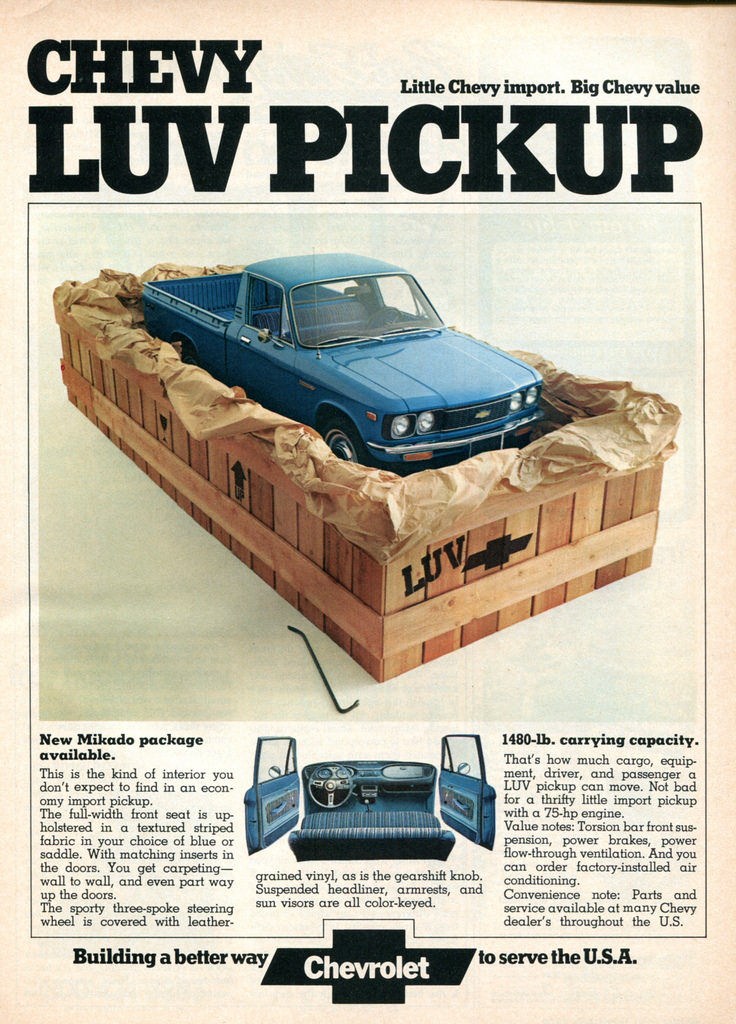
GM’s ace in the hole when it came to dealing with the nascent mini-truck madness was that it owned a sizable chunk of Isuzu. After a few terse phone calls, Chevrolet had its first compact truck ready to go, sent across the Pacific in droves to America where it would receive both the Bowtie and the unusual “LUV” badge, an acronym for Light Utility Vehicle.
The LUV was as basic as you could get when it appeared in 1972, offering a 1.8-liter, 75-horsepower, four-cylinder engine; four-speed manual gearbox; and 88 lb-ft of shrub-pulling torque. With a 102.4-inch wheelbase and 1400 pounds of cargo capacity, Isuzu’s finest was a paragon of pint-sized practicality.
In 1976, the LUV would gain a three-speed automatic and front disc brakes. By the end of the decade it was possible to snag a chassis-cab version of the truck, choose between 6- and 7.5-foot bed lengths, add four-wheel drive, and benefit from an additional five horsepower from an upgraded four-banger. A number of styling changes would also come and go with the Chevrolet, including a switch from quad headlights to a simple pair in 1978.
Chevrolet was strategic in spreading the LUV, making the truck available first in parts of the country where buyers had already demonstrated significant interest in smaller pickups. As a result, the LUV sold in huge numbers, with sales shooting from just over 20,000 in its first year all the way to a peak of more than 100,000 in 1979.
The second-generation truck that appeared in 1981 adopted styling that resonated with fewer buyers, but it wouldn’t matter that sales were cratering because the S10 was right on the horizon—and besides, Chevy had little to complain about having moved 462,000 LUV units since the model was introduced. Not bad for a segment that no one saw coming.
Ford Courier

The Ford Courier was another example of an American institution leaning on a Japanese partner to fill a hole in its product planning. In 1972, Mazda was already selling the B1600 in the United States (and had been offering the more powerful B1800 in Canada since 1970), but it hardly minded when the Blue Oval strong-armed its way into the mini-truck mix by rebadging the B1600 as the Courier. Besides, Mazda had the Rotary Pickup waiting in the wings, so what did it matter if Ford wanted a few thousand piston-driven trucks in the meantime?
Ford took a more aggressive approach to updating the Courier than Chevy did with the LUV, at least when it came to drivetrain choices. Whereas the LUV would stick with its original powerplant throughout its entire production run, the Courier’s initial 1.8-liter four—with 74-hp and 92 lb-ft of torque—was eventually complemented by a roughly 90-hp, 2.3-liter option lifted from the Pinto (for its 1977 redesign), and then replaced entirely by a 2.0-liter mill (in ’79).
Ford also made a three-speed automatic available alongside the truck’s standard four-speed manual right from the start, adding a five-speed option in 1976. Strangely, despite the ostensibly identical Mazda delivering 2250 pounds of cargo capacity, the Courier matched the LUV with an advertised 1400-pound carry rating.
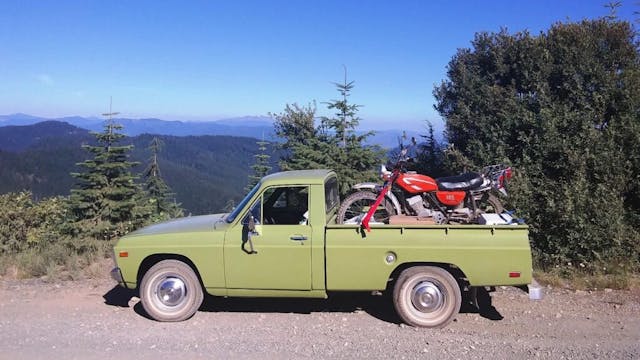
Other changes throughout the decade included the unusual decision to lengthen the cab by three inches in 1976, one year before the second-generation model debuted. Also strange was the availability of third-party four-wheel drive (most notably under the Courier Sasquatch name) in the absence of a Ford-developed system.
If you’re an EV historian, then you’ll also be intrigued by the ultra-rare Jet Industries ElectraVan 750, a battery-powered version of the Courier that offered 60 miles of range on a single charge.
The Courier would survive until 1982, when it was retired in favor of next year’s iconic Ranger.
Dodge D-50 / Plymouth Arrow
20180716162248)
Chrysler leaned on its long-standing history with Mitsubishi when it came time to tackle the surging mini-truck threat. Unlike Mazda and Isuzu, however, Mitsubishi was pickup-poor throughout most of the ’70s, leaving the Pentastar on the outside looking in at all of the action being soaked up by Ford and GM.
It wasn’t until 1979 that Dodge would import the Mitsubishi Forte, which had gone into production the year before, relabeling it the “D-50.” Deciding that the best way to make up for lost time was to double its efforts, Chrysler also tagged Plymouth into the pickup game with the Plymouth Arrow, which was identical to the Dodge.
With a wheelbase seven inches longer than that of the LUV, and featuring a choice of engines delivering between 93 (from a 2.0-liter four) and 108 (from 2.6-liter four) horsepower, the Mitsubishi twins were certainly competitive. This was especially true when considering the larger motor’s 139 lb-ft of torque, and the availability of three, four, or five forward gears. Payload remained locked at the seemingly industry-standard 1400 pounds and was delivered by a 6.5-foot bed (with another 100 pounds of bed capacity added the following year).
In 1981, the D-50 would be renamed the Ram 50, and while the Arrow would disappear by 1982, the Dodge version would continue on for an astonishing 13 additional years (finally leaving the American market in 1994). During that time it would gain four-wheel drive, a four-door model (in addition to extended-cab versions), and endure a brief flirtation with diesel power.

Why did the Ram 50 endure? Truth be told, Chrysler was in total chaos in the early ’80s and had no money to throw at a dedicated compact-pickup platform. While Ford fans and Chevy loyalists were enjoying the Ranger and S10 for the 1982 and ’83 model years, Mopar maniacs were instead gifted with the ultra-weird (and short-lived) Dodge Rampage and Plymouth Scamp, L-body front-wheel-drive haulers that had more in common with the Subaru Brat than they did a legitimate truck. These were followed by the unibody Jeep Comanche in the middle of the decade, which was itself joined by the mid-size, and full-frame, Dodge Dakota in 1987, creating a confusing-at-best situation at Mopar dealerships for much of the ’80s.
That confusion seems appropriate considering how long it took the Big Three to figure out there was a mini-truck market in the first place.
Check out the Hagerty Media homepage so you don’t miss a single story, or better yet, bookmark it. To get our best stories delivered right to your inbox, subscribe to our newsletters.









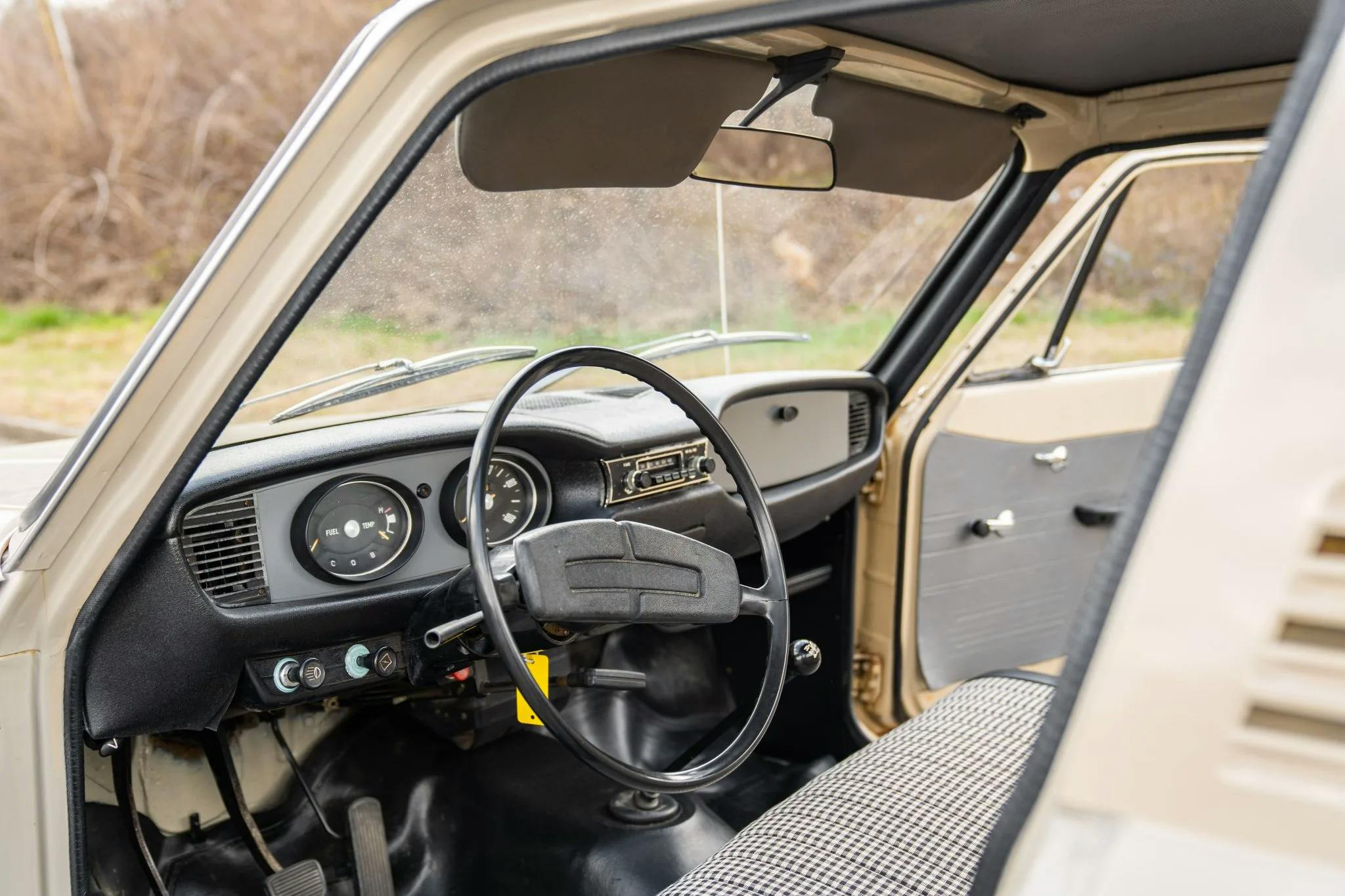
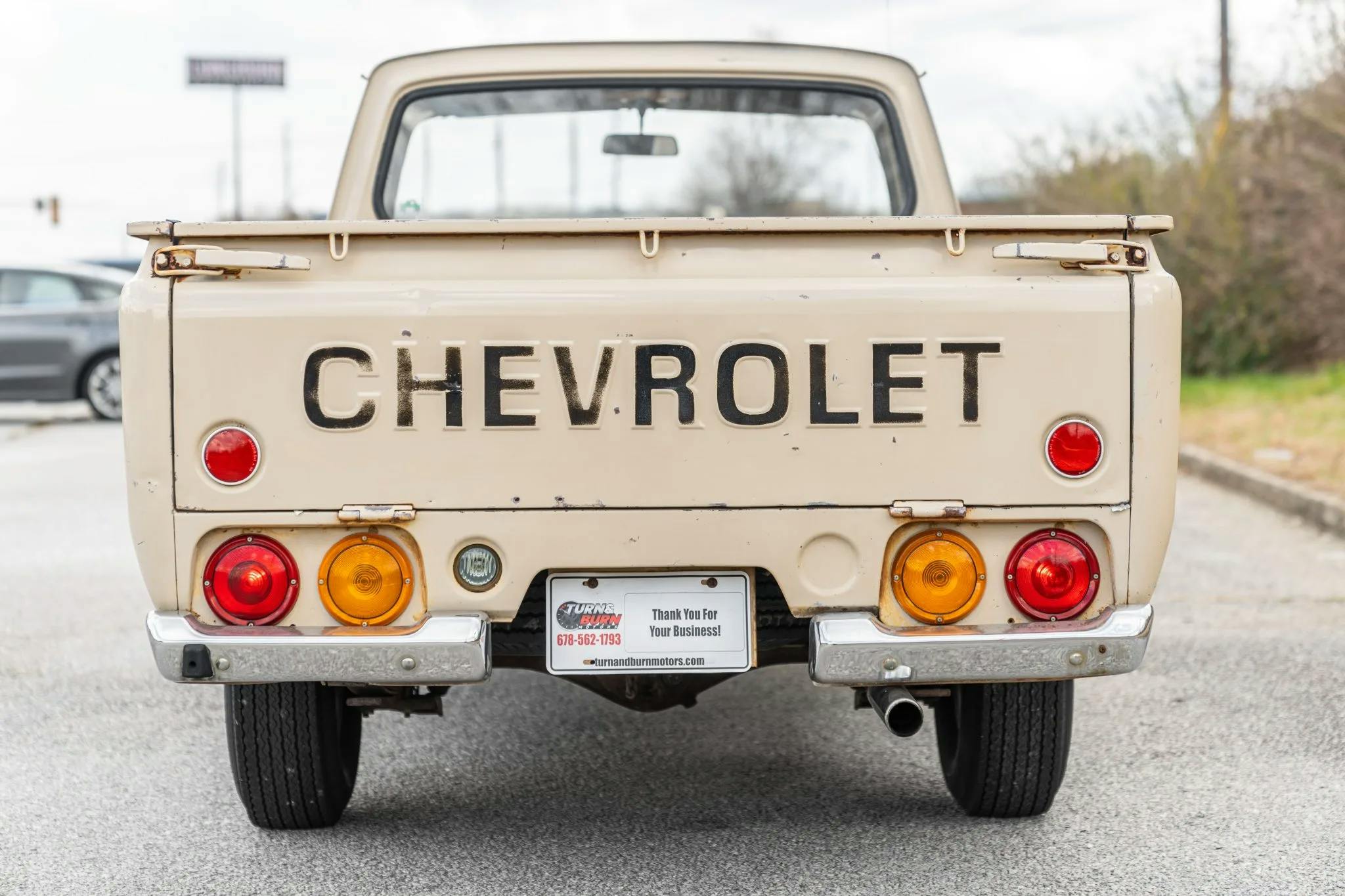

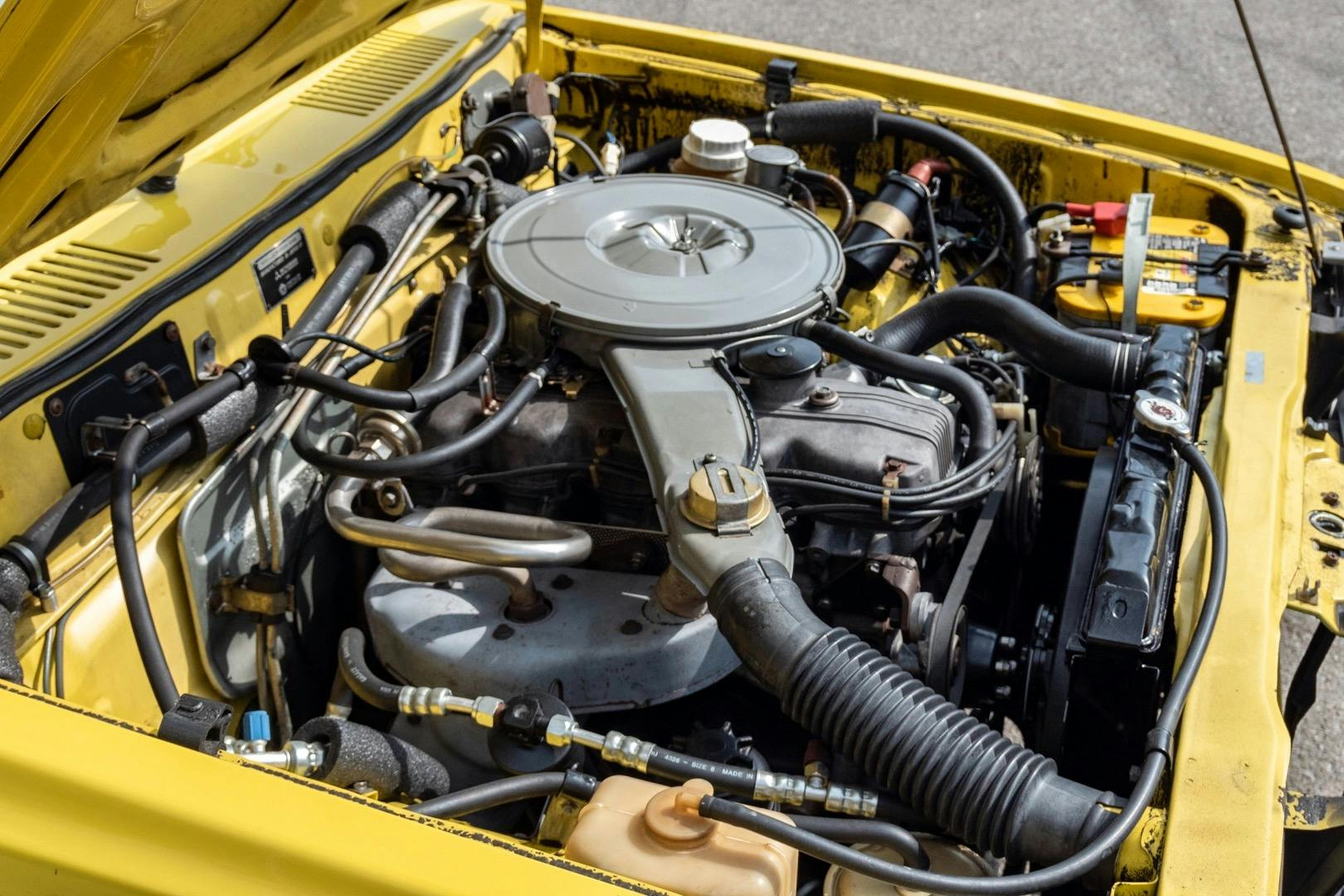

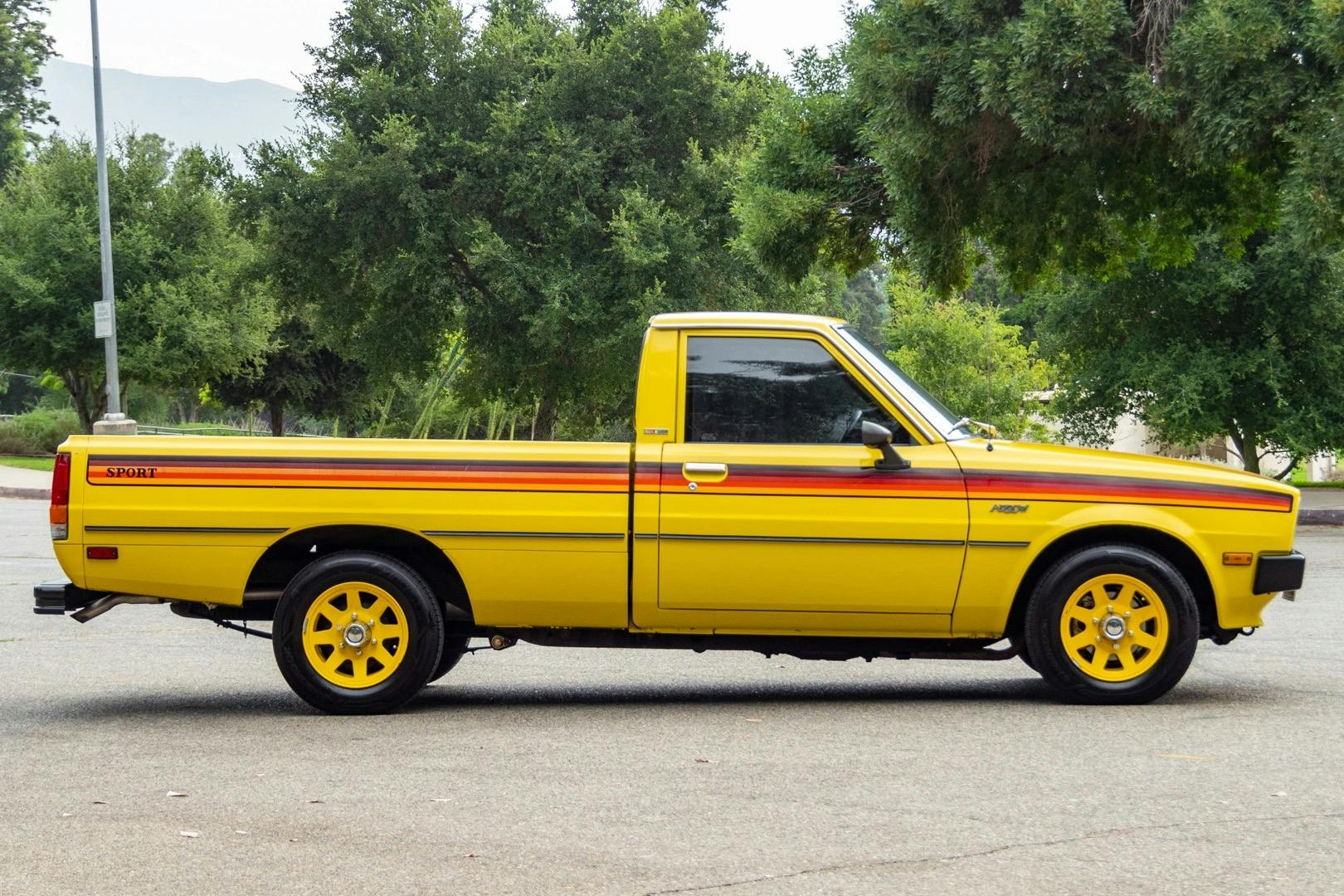













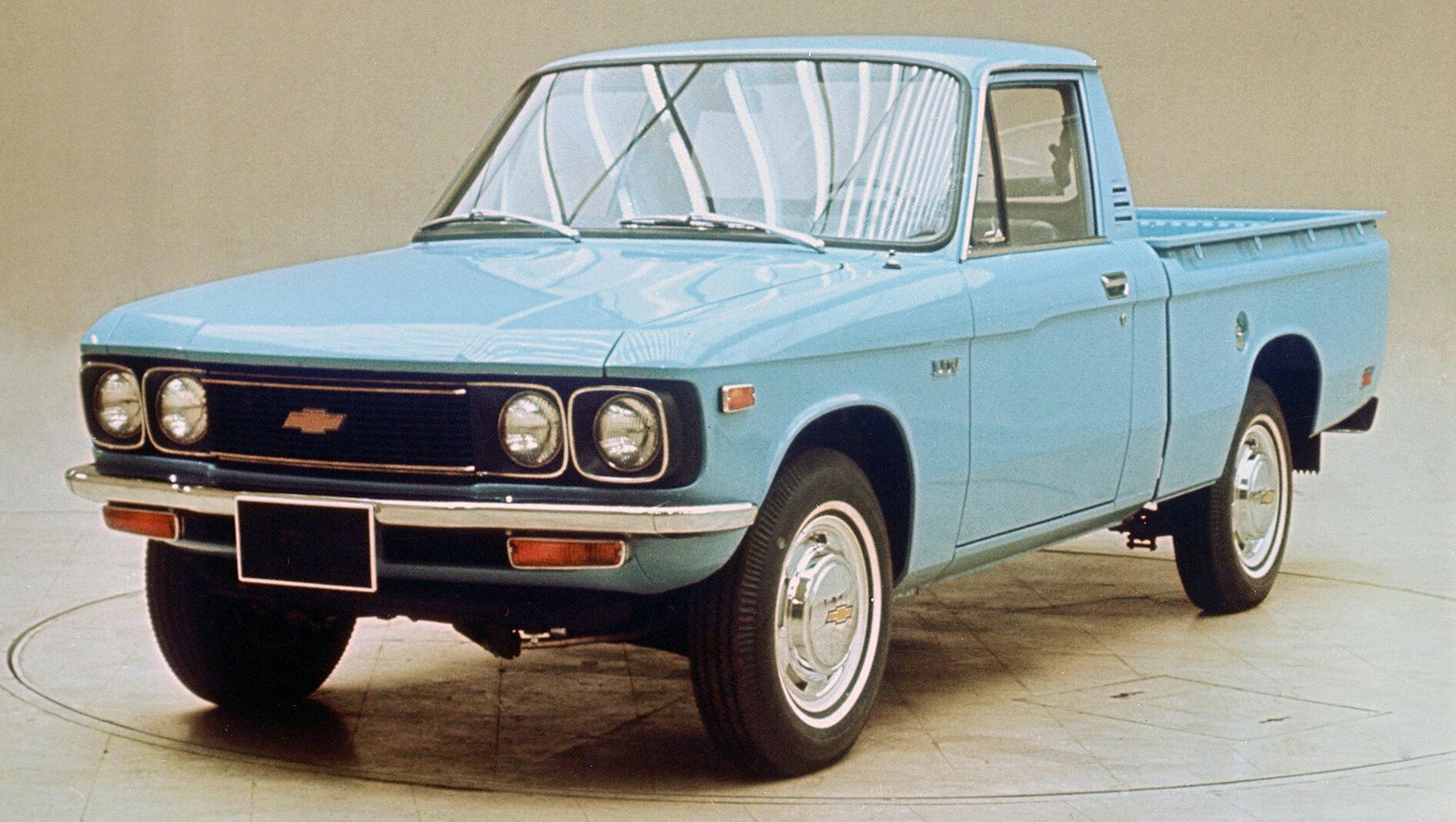
In the early 90s, I had so much fun carving corners in my ‘82 VW Pickup. It had lowered Eibach suspension, lightweight German ATS wheels on sticky Yokohama A008s with a swapped 1.8L Scirocco motor/5-speed manual. I had the rear bumper removed for a custom roll pan and the tailgate smoothed. People would notice the truck, but mistake it for a Subaru Brat! I couldn’t haul much, but good times.
I had an Izuzu P’up in the 80’s. I used it for eveything. Was cheap but reliable. Sold it 16 years later, still in good shape, for $1200. But my favorite small truck was the 2003 Chevy S-10 ZR5 4D with crew cab and short bed. I loved that truck and used it mostly for business. It had style and power for its size. I even pulled a big Chrysler out of a ditch with it! I hated trading it in 15 years later with only 38,000 miles on it but, unfortunately, the fenders did not hold up to the Pennsylvania road salt. Loved that little truck! Wish they still made them.
Correction… There was 58,000 miles on the Chevy S-10. Still low mileage for the years I drove it.
The “people want bigger trucks and 4 door trucks” lie needs to be exposed once and for all. Auto makers”want” these vehicles to skirt regulations and increase profits. The trucks they make today are too large (except for the beds) are way too heavy, and make the roads much more dangerous. People want trucks like these mini trucks and trucks like the 1970 F150 – wind up windows, rubber floor mat, vinyl seats, a reliable torquey engine and automatic tranny along with a bed you can fit a sheet of plywd or a motorcycle or a refrigerator.
The main problem with the captive import trucks–along with both contemporary Datsuns and Toyotas–was they rusted like crazy in salt-laden climates. Mechanically they were pretty robust, but the sheet metal, not so much. It took both Nissan and Toyota until the late 1990s before they finally got that right.
And it’s a shame that the current equivalent of those compact trucks of the 70s and 80s are no longer compact. My 72 Datsun truck was 172″ long with an 84″ box; my 2007 Nissan Frontier is 206″ long (admittedly with an extended cab) but with the same 84″ box. Not all that 34″ difference is behind the front seats…
The reason all those import trucks back then were rated at 1400-1500 lbs capacity was that if rated over 1 ton they would have incurred an additional import duty. My ’72 Datsun 521 truck was rated at 1000 lbs, but according to its shop manual, the identical truck for the “rest of the world” market (same wheels/tires and springs) was rated at 1000 kg (2250 lbs). After hauling 225 bricks in the truck, and later filling the box with old foundation stones, I experienced the latter.
Mazda B2200, was another nice truck, made by Ford? 1989 model and still running!
A young man, in the mid 80’s, I had a 76 Mikado with a camper shell on it, and it was a great little truck. Fast forward about a decade, and I bought a used 82 LUV with a long wheel base, and a 4cyl diesel with a 5sp in it. The fuel gauge was broken, so I always wrote my miles down at every fill up, to insure that I didn’t run out. So, I promise my numbers are accurate when I say that I averaged 45 mpg in the city, and 54 mpg on the highway. I miss that little truck.
In the early 80’s I had a “78 Chevy Luv stepside with custom rainbow striping. Put a matching camper shell on it to haul skis and what not from Builder up into the mountains. Fun times in that little truck though it was severely under-powered by its little Isuzu 4-banger
They didn’t mention the diesel powerplant you could get in the LUV
In ’82 I got my first Ranger, an ’83 base model. In ’92 I updated to a top trim model ’92 Ranger. In ’02 traded it in for an’02 Sport-Trac, (basically a 4-door Ranger). The last few years I have been (seriously) thinking of a new Ranger, or Maverick, but nope, still daily driving the Sport-Trac.
Have a few of them 4×4 are a tough little truck
We’ve had several S10/S15 trucks, but my favorite was the one my Dad bought new for my brother when he started college. $6400 for a 1991 iron duke 5 speed S15. The only options were the rally wheels. It didn’t even have a radio. My brother drove it until he got his 1st job then gave it to my Dad who drove it, in Michigan, for 15 years or so. He stopped by one day and said he thought it was on it’s last leg because the motor was ticking. I opened the hood and poked around and found that the core support and body mounts were all gone and the rad fan was hitting the fan shroud. Walked around to the back and found I could lift the whole bed off the frame. The only thing holding it was a ground strap and the wiring. I told Dad he needs to let it go.
When Toyota brings out the new Stout, oh it’s game over for all of you
The small truck market is a difficult one to do. Large trucks are built with shared parts at over a Million units whereas the smaller truck see much lower volumes.
The small trucks have been nearly as expensive to build as a full size as they share little with anything else.
In years past the S10 and Ranger shared parts with mid sized sedans and it help off set some of the costs. but then people stopped buying them
Many found that the small trucks were short of hauling and at best you could haul 3 people only.
Some may claim it a big lie but the crews sell. Numbers do not like.
I grew up around a Luv truck and it was cool looking with the hood that opened like a Vette but it was not durable. It also rusted out like a Vega.
I owned my share of S10 and Sonoma models. I liked them but you had to choose large bed or small bed and passenger room.
I now have a Canyon. It is a crew it hauls the entire family. It gets better MPG than my Sonoma and hauls more and had 4×4.
These small trucks like the Maverick are trucks for people who really don’t need a truck. They are limited in hauling and towing. They are really just a small sedan with a bed. They will not haul 36 bags or mulch or an engine and transmission. Even my El Camino could haul the engine and tranny,
Full size is larger than I need and the present mid size is just right. But with the limited profits they are not going to offer 101 variations of them. Long beds and extended cabs or engine offerings are going to be limited.
The Maverick has sold ok and sales have been limited due to limited production. It has not saved Ford as their stock is still in the tank. If you note the other companies have been watching but most have not rushed a similar truck to market. Honda has seen limited success with their Ridgeline. Many wonder how they have stuck with it as long as they have.
We all like to wax poetically on the small trucks of the past but I lived and owned it. They were far from perfect.
The one I do miss is the Sonoma and it was missed as it has the ZQ8 suspension. It was like a small Camaro truck. I just wish it had more room and power. The 4.3 did not get good MPG or power.